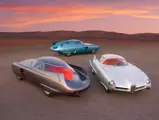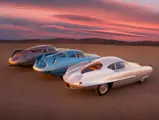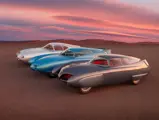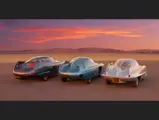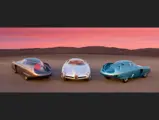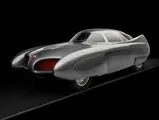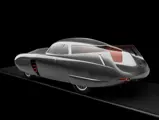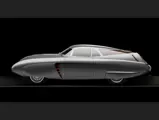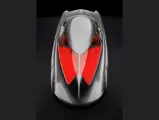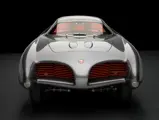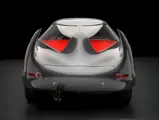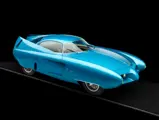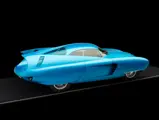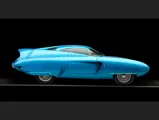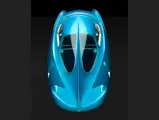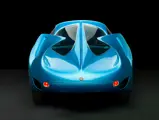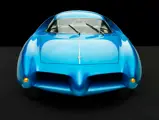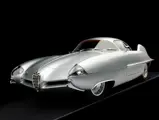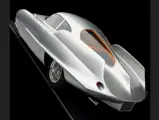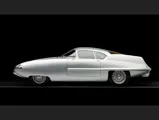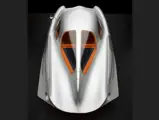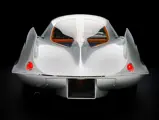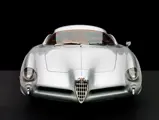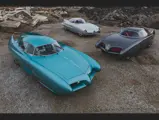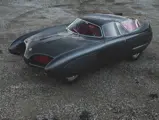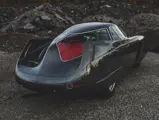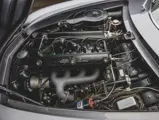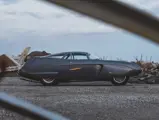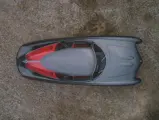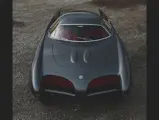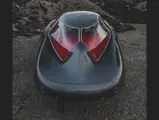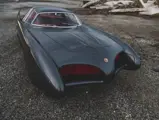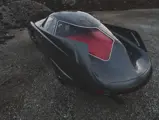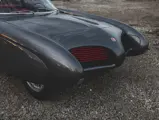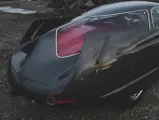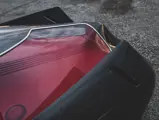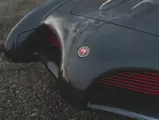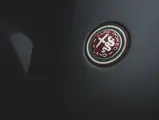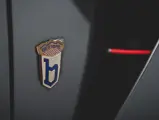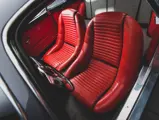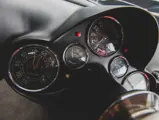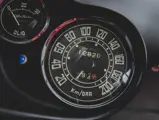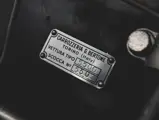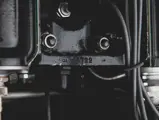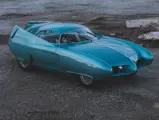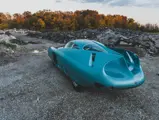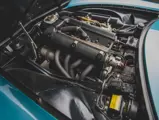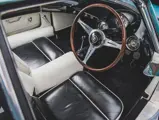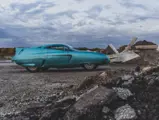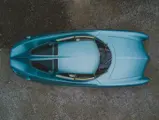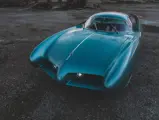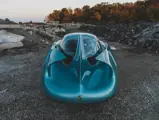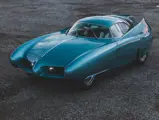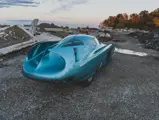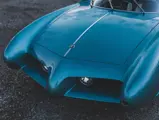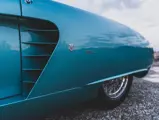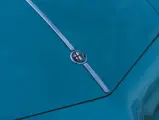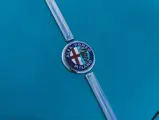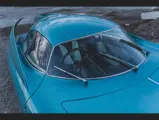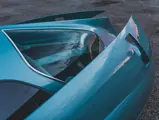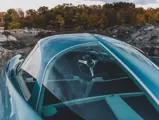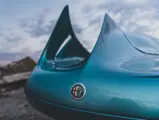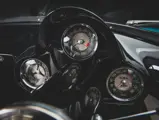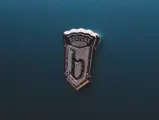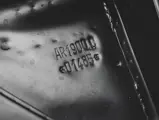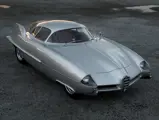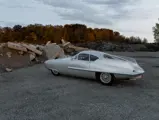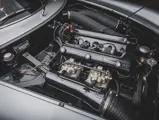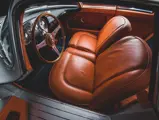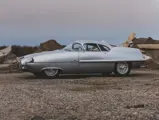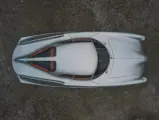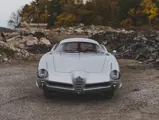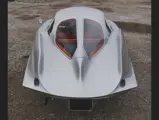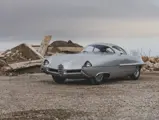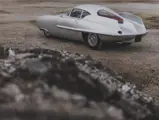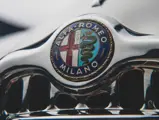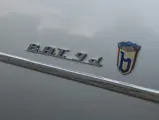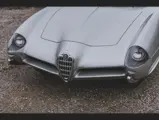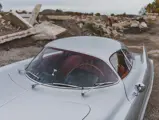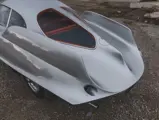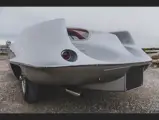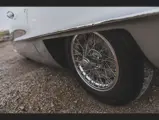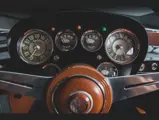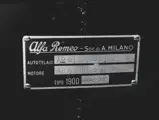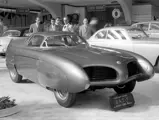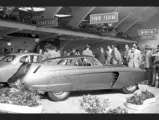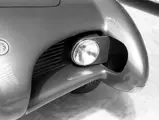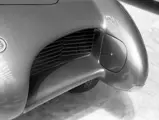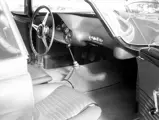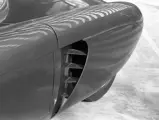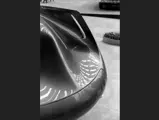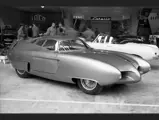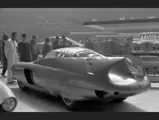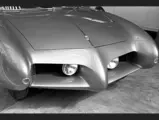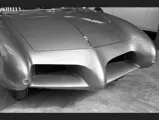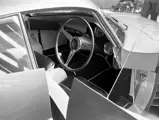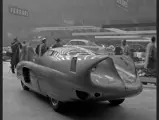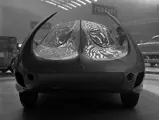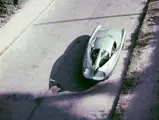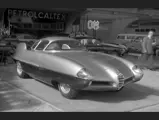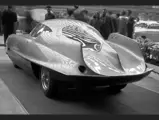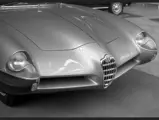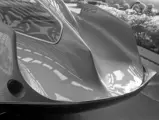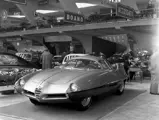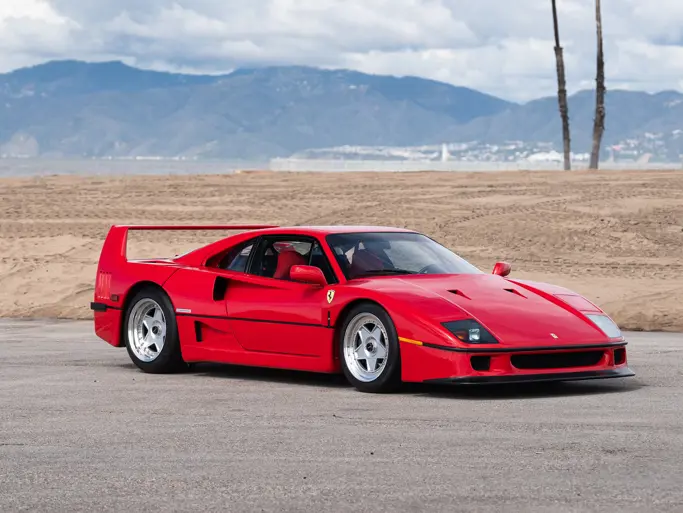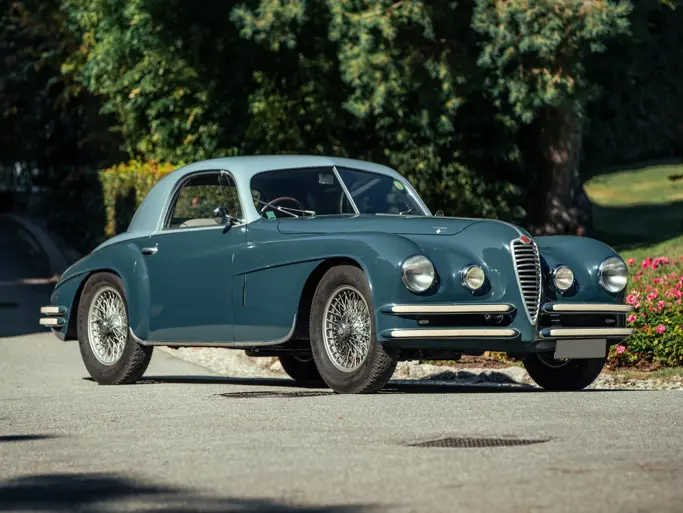1953 Alfa Romeo B.A.T. 5
Chassis no. AR1900 01396
1954 Alfa Romeo B.A.T. 7
Chassis no. AR1900C 01485
1955 Alfa Romeo B.A.T. 9d
Chassis no. AR1900 01600
Coachwork by Carrozzeria Bertone
Design by Franco Scaglione
Contemporary Art Evening Auction
Alfa Romeo Berlina Aerodinamica Tecnica 5-7-9d
An Automotive Triptych of Unparalleled Significance
{{lr.item.text}}
$14,840,000 USD | Sold
 | New York, New York
| New York, New York
{{internetCurrentBid}}
{{internetTimeLeft}}

Unconstrained by the limitations of budget and the realities of manufacturing, concept cars afford talented designers the opportunity to explore their wildest and most progressive ideas. At their best, these dazzling, artistic creations invite us to totally reimagine what the automobile can be.
As in the world of fashion, however, car design evolves quickly; it is unusual to find a concept that remains relevant after its allotted time in the spotlight comes to an end, let alone one that is still compelling over six decades after its debut. Rarer still is the concept that transcends its role as a design exercise to embody the sculptural potential of the automotive form. And when it comes to a trilogy of concepts that effortlessly achieves both feats, there is but one spectacular example: The Alfa Romeo Berlina Aerodinamica Tecnica series by Franco Scaglione.
Whether considered the ultimate three-movement concerto of automobile design or the only true automotive triptych ever produced, few will contest the greatness of the B.A.T. 5, 7, and 9d concepts. Hand-built by the storied Carrozzeria Bertone of Turin, Italy and introduced in 1953, 1954, and 1955, respectively, these cars were pioneering in their use of aerodynamics. With flamboyant aesthetics that simultaneously minimized drag for optimal performance, the B.A.T. cars were immediately and enthusiastically embraced by press and public alike.
Individually, each of the B.A.T.s is, without exaggeration, among the most important automotive concepts ever built. Presented collectively, their significance deepens: Uniquely in the automotive world, the B.A.T.s are best understood as variations on a singular theme, a complete work in three parts. Like a Francis Bacon triptych, examining one car in the context of the other two reveals new aspects of their forms, as well as the captivating details incorporated into the hand-shaped bodywork of each.
Put simply, since the inception of the internal combustion engine, no one vehicle—let alone an interwoven trilogy—has so compellingly explored the concept of the automobile as pure kinetic sculpture as the Alfa Romeo B.A.T. 5, 7, and 9d.
THE VISION OF FRANCO SCAGLIONE
The greatest cars in the world, and indeed, the ones that completely re-write the course of automotive history, are the products of brilliant creative minds—engineers who rethink what is possible in terms of performance, captains of industry who envision a new paradigm of transport, and more often than not, designers whose sketches and clay models are years ahead of their time.
The world’s very best car designers are legends of the industry, from Harley Earl to Ian Callum, whose pencil strokes are immediately recognizable in the finished product. Franco Scaglione was one such iconic designer.
Franco Scaglione was born on 26 September 1916 in Florence, Italy, to Vittorio Scaglione, a chief army doctor, and Giovanna Fabbri, captain of the Italian Red Cross service. Franco would ultimately follow in his parents’ footsteps and join the military ranks at the outbreak of World War II. At War’s end, in early 1948, Franco travelled to Bologna in pursuit of work, with his mind set on becoming a car stylist in Italy’s rebuilding auto industry.
Initially he spent his time sketching clothing for various fashion houses. Though the work turned out to be lucrative, it did not fulfil his passion for working in automotive design. Looking toward the major coachbuilding firms, he relocated to Torino in 1951 where he reached out to Battista “Pinin” Farina, though a collaboration never materialized. Shortly thereafter, however, Franco met the great Giuseppe “Nuccio” Bertone, and a partnership was born.
CARROZZERIA BERTONE AND BERLINA AERODINAMICA TECNICA
At the dawn of the 1950s, Nuccio Bertone’s carrozzeria, the design house and coachbuilder responsible for penning and constructing hand-made car bodies, was struggling in the face of postwar recovery. One-off commissions for wealthy clients, once the lifeblood of the coachbuilding trade, represented a decreasingly viable business strategy. Meanwhile, the idea of a concept car—an automobile built primarily to push the limits of creativity, rather than to closely preview a future product—was far from widespread.
That began to change when Franco Scaglione entered the picture. The 1951 hiring of a then-largely unknown designer with a background in aeronautics soon resulted in the some of the firm’s most celebrated works, catapulting both Scaglione and Bertone to enduring fame.
Following the success of the Scaglione-designed and Bertone-built Abarth 1500 Biposto in 1952, Alfa Romeo expressed interest in exploring a technical proposal into aerodynamics. Bertone chose the modern 1900 platform as a testbed for this research, and Scaglione relished the opportunity to combine his interests in science and mathematics with his aesthetic leanings. He later wrote of the vehicle’s guiding manifesto in a 1954 article in Auto Italiana, arguing that aerodynamic considerations accounted for as much as 85 percent of a car’s efficiency, and concluding “the entry form must give a smooth penetration.”
From this relatively simple principle, Scaglione would derive the three automotive jewels that would make up the revolutionary Berlina Aerodinamica Tecnica series.

B.A.T. 5 (1953)
With firm ideas about the minimization of drag by shaping laminar airflow and stability with the car’s exterior form in mind, Scaglione progressively worked through four full-size models before proceeding to the fifth and final stage, the actual metalwork for the car. When completed, the concept car was appropriately dubbed the Berlina Aerodinamica Tecnica 5, or B.A.T. 5.
Instantly striking to even a casual observer, the B.A.T. 5’s protruding pontoon fenders and rounded center nose ducted airflow over the swept hood, whose low profile was accommodated by an engine modified with side-draft carburetors. Frontal air was channeled into dual nose vents with horizontal slots that directly fed the radiator core. Topside airflow was ducted over a slippery teardrop-shaped wraparound-glass cockpit, and over rear shoulders enclosed by leaning tailfins. The fins gently curved together toward the tapered rear, with airflow further stabilized by a central rear spine. Rear wheel skirts were fitted to reduce reverse airflow from the wheel’s topside, and large side vents provided exhaust for the front brakes.
Notably, and despite its radical looks, Scaglione designed the B.A.T. 5 and its successors with road-legal drivability (if not comfortable, practical long-distance touring) in mind. Over the years, many have claimed, incorrectly, that Scaglione’s dogged pursuit of aerodynamic efficiency meant that the car did away from headlamps. The headlamps are in fact designed to swing away and into the fenders when not required—one of many demonstrations of Scaglione’s ability to skillfully incorporate functional engineering solutions into what might have otherwise been a visually indulgent flight of fancy.
In addition to its arresting appearance and jet-age character, Scaglione’s coachwork was remarkable for its advanced aerodynamics. Figures vary slightly (analytical methods of the time were primitive by today’s standards) but the B.A.T. 5 is said to have achieved a coefficient of drag of roughly 0.23 at nearly 94 mph, all at a low power output of under 43 horsepower. The top speed was tested at 123.6 mph, an impressive metric given the era and the car’s relatively small four-cylinder engine.
The B.A.T. 5 made its public debut at the Turin Auto Salon in May 1953, drawing rapturous coverage from the international motoring press. In October 1953, Bertone sold the concept car to American importer Stanley “Wacky” Arnolt, and it was then displayed in the United States at Herb Shriner’s auto shows. After repainting the car a darker silver, Arnolt drove it personally for several years while displaying it at his Hoosier International Motors showroom in Warsaw, Indiana.
In 1956 Arnolt sold the Alfa Romeo to his friend Joe Prysak of South Bend, and he devised a way to hang the car from the rafters of his specialty shop, where it was displayed for many years. After 30 years of ownership, Prysak finally offered the B.A.T. 5 for sale in 1987, and it was then purchased by Said Marouf of La Jolla, California. Following a year-long restoration to the original color configuration, the important concept car was shown at the Pebble Beach Concours d’Elegance in August 1988, winning a class award. It would return a year later for something even more spectacular.

B.A.T. 7 (1954)
As is often the case with concept cars, the B.A.T. 5 was essentially mothballed after the 1953 show season as work commenced on an updated version, soon to be known as the B.A.T. 7. Running gear would once again be sourced from the Alfa Romeo 1900, but given the first car’s success, Scaglione was encouraged to emphasize various characteristics of the original. He obliged by narrowing the front air intakes, lowering the hood by over two inches, and lengthening the tailfins while adding increased angular pitch to the extremities. The rear wheel skirts and pronounced side vents remained.
Again, however, Scaglione judiciously avoided the trap of self-indulgence. Granted license to create a more extreme design, he also created one that was more extreme in terms of aerodynamics as well: The B.A.T. 7’s coefficient of drag was, at 0.19, even more remarkable than that of its predecessor. Consider that a Toyota Prius and a Tesla Model S, two paragons of modern efficiency, achieve a 0.24 Cd; Scaglione soundly bested both in an era without widespread wind tunnel testing or computer-aided design. Weight was reduced as well, from the B.A.T. 5’s roughly 2,400 pounds to just 2,200 pounds.
Scheduled to be unveiled at the Turin Salon in April 1954, the B.A.T. 7 required feverish preparation to complete, and it was finished so late that Nuccio Bertone and Franco Scaglione personally drove the car to Turin. Response at the show was unequivocally positive, as the B.A.T. 7 received even more enthusiastic praise from the media than its predecessor, making the cover of Swiss magazine Automobil Revue.
Following the 1954 show season, the B.A.T. 7 was acquired by Alfa Romeo in January 1955 and shipped to the United States for display by the manufacturer at the New York and Chicago Auto Shows. Shortly thereafter the car was purchased by the well-known San Francisco-based importer Charles Rezzaghi on behalf of Alfa Romeo enthusiast Al Williams, a flamboyant restaurateur whose Fairmont Hotel penthouse establishment hosted many of the day’s A-list celebrities. The B.A.T. 7 was soon transported to Southern California to run the SCCA races at Palm Springs in March 1955, and afterwards it was displayed at Bill Doheny’s Ferrari sales office in Los Angeles.
After returning to San Francisco, the B.A.T. 7 was modified with the removal of the fins; while this decision is no doubt shocking to a modern observer, it must be noted that these dramatic design features obstructed rear visibility and therefore made street use exceedingly difficult. Acquired then by Ken Shaff, the Alfa Romeo was repainted in Rolls-Royce sand and black, and presented at the 1958 Pebble Beach Concours d’Elegance.
Passing to collector Col. James Sorrell, the B.A.T. 7 was entrusted to the Van Nuys shop of Sal di Natale, then one of the West Coast’s most respected Italian car specialists. After undergoing a sympathetic freshening, the Alfa Romeo sat uncollected for some time, prompting di Natale to eventually put a lien on it and assume ownership around 1969. The mechanic went on to retain possession for 17 years, eventually selling the car in 1986 to a private collector, at which time a two-year refurbishment was conducted of the coachwork, including reinstallation of the fins, to its original configuration.

B.A.T. 9d (1955)
Following the B.A.T. 7’s show season of 1954, Scaglione began work on a third concept for 1955. Perhaps sensing some missed opportunity—as popular as the prior B.A.T.s were, they looked utterly unlike anything sold by Alfa Romeo—Alfa Romeo’s mandate for the final B.A.T concept was to “make it more practical for road use.”
Thus, for his third act, Scaglione explored a roadworthy gran turismo interpretation of the B.A.T theme. The fins were reduced in size to improve rear visibility, and the rear wheel skirts were eliminated. A pronounced beltline was added toward the rear, while a standard production triangular Alfa Romeo Giulietta grille, including the famed Milano crest, was fitted to the front grille, highlighting the car’s identity as an Alfa Romeo. And, of course, the mechanical components were once again drawn from the Alfa Romeo 1900.
The Turin Salon was again chosen to unveil the new concept car, and the B.A.T. 9d was unsurprisingly lavished with high praise, completing one of the most important automotive triptychs ever devised. After the 1955 show season, this final concept car was sold into American ownership, and it next surfaced in the parking lot of the Sebring endurance race in March 1956. The B.A.T. 9d was discovered there by Chicago dealer Harry Woodnorth, and he, along with Tom Barrett, arranged a purchase after patiently waiting for the car’s owners to return.
Barrett later sold his share of the car to Woodnorth, and in 1958 Woodnorth in turn sold the Alfa Romeo to Ed Beseler of Lansing, Michigan, who repainted the body red. After Beseler’s passing a few years later, the B.A.T. 9d was purchased by Arlen Regis at an estate sale, and he prominently displayed the car at the dealership he managed, Chapin Motors of Greenville, Michigan. In 1962, 16-year-old Gary Kaberle spotted the car at the dealership and began relentlessly hounding Regis to sell it to him, eventually emptying a gym bag of cash onto the dealer’s desk to trigger a transaction.
Kaberle retained the B.A.T. 9d for 28 years, and it served as his transport while he earned his D.D.S. Continually maintaining the Alfa Romeo, he presented the car at the Henry Ford Museum’s annual Sports Cars in Review in the late 1960s. After receiving an invitation to display the car at the Meadow Brook Concours d’Elegance in 1987, Dr. Kaberle arranged to refinish the aging exterior, opting to repaint it in silver.
AN AUTOMOTIVE TRIPTYCH, UNITED
Study the histories of these three concepts and a surprising fact emerges: Despite their individual popularity and collective significance, the B.A.T.s were never displayed together when new. But as each of the three B.A.T. cars came to the attention of collectors in 1987, concours organizers began to dream of assembling all three in one exhibitive setting.
The precipitating event was Nuccio Bertone’s visit to Pasadena, California’s Art Center College of Design in 1989 to receive an honorary degree. Seizing the opportunity, organizers of the Pebble Beach Concours d’Elegance invited the three owners of the B.A.T.s to the 1989 show, and the elder coachbuilder was encouraged to travel up the coast for the occasion. With the three cars displayed together for the first time in their history, Nuccio Bertone shared nostalgic anecdotes of his experiences with Franco Scaglione.
Recognizing the unique appeal of keeping all three B.A.T.s together, a private collector made an offer to each of the three owners, and the cars became united in ownership as well. Together, the B.A.T.s traveled to Europe during the early 1990s, being shown at the Genoa Autostory in February 1992, the 80th Anniversary of Bertone held in Turin, the Centre International de l’Automobile in Pantin, Paris, and Rétromobile held in Versailles in February 1993.
The concept cars were then sent to the Blackhawk Museum in Danville, California, where they had been on display for over a decade. Exhibition during this period included a trip to the Museum of Science in South Kensington, London, and presentation at Coys International Historic Festival in July 1994. In August 2005, the three B.A.T.s returned to Pebble Beach, and in 2009 they were presented at Concorso Italiano.
The important cars have also been exhibited at world-class motoring events such as the Cartier Style et Luxe at Goodwood, the Louis Vuitton Bagatelle Concours d‘Elegance, and the Villa d’Este Concorso d’Eleganza. Underscoring their broad appeal and significance as objects of mechanical art, the three B.A.T.s were shown alongside a carefully curated collection of significant Italian cars at the Frist Center for the Visual Arts in Nashville, Tennessee in 2016.
Aerodynamically advanced, visually arresting, and hugely influential, Franco Scaglione’s Alfa Romeo B.A.T. 5, 7, and 9d occupy an intriguing space between driveable automobiles and pure kinetic sculpture. It is incredibly unique for three such concept cars to have been collectively owned and maintained for so long. Offered together, this rare and exciting opportunity affords discerning collectors a chance to acquire perhaps the most celebrated trio of series-conceived concept cars in automotive history—a triptych in which form and function strike a perfect, compelling balance.
Welcome at the most prestigious international concours d’elegance and design exhibitions worldwide, this striking trio would be a crowning achievement of any collection of cars and art.

